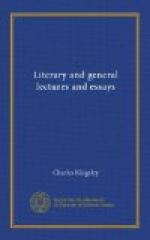Throughout all these exquisite lines occurs but one instance of what the vulgar call “poetic diction.” All is simple description, in short and Saxon words, and yet who can deny the effect to be perfect--superior to any similar passage in Wordsworth? And why? Because the passage quoted, and indeed the whole poem, is perfect in what artists call tone—tone in the metre and in the sound of the words, as well as in the images and the feelings expressed. The weariness, the dreariness, the dark mysterious waste, exist alike within and without, in the slow monotonous pace of the metre and the words, as well as in the boundless fen, and the heart of her who, “without hope of change, in sleep did seem to walk forlorn.”
The same faith in Nature, the same instinctive correctness in melody, springing from that correct insight into Nature, ran through the poems inspired by medieval legends. The very spirit of the old ballad writers, with their combinations of mysticism and objectivity, their freedom from any self-conscious attempt at reflective epithets or figures, runs through them all. We are never jarred in them, as we are in all the attempts at ballad-writing and ballad-restoring before Mr. Tennyson’s time, by discordant touches of the reflective in thought, the picturesque in Nature, or the theatric in action. To illustrate our meaning, readers may remember the ballad of “Fair Emmeline,” in Bishop Percy’s “Reliques.” The bishop confesses, if we mistake not, to have patched one end of the ballad. He need not have informed us of that fact, while such lines as these following meet our eyes:
The Baron turned
aside,
And wiped away the rising tears
He proudly strove to hide.
No old ballad writer would have used such a complicated concetto. Another, and even a worse instance is to be found in the difference between the old and new versions of the grand ballad of “Glasgerion.” In the original, we hear how the elfin harper could
Harp fish out of the water,
And water out of a stone,
And milk out of a maiden’s breast
That bairn had never none.
For which some benighted “restorer” substitutes—
Oh, there was magic in his touch,
And sorcery in his string!
No doubt there was. But while the new poetaster informs you of the abstract notion, the ancient poet gives you the concrete fact; as Mr. Tennyson has done with wonderful art in his exquisite “St. Agnes,” where the saint’s subjective mysticism appears only as embodied in objective pictures:
Break up the heavens, oh Lord! and far
Through all yon starlight keen
Draw me, thy bride, a glittering star,
In raiment white and clean.




